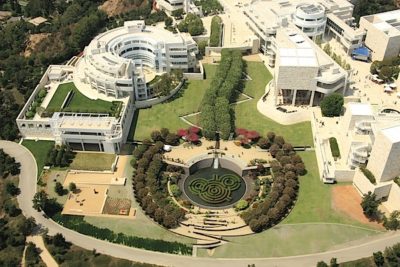Flourishing Getty Center forest, 20 years on, among most beautiful

GETTY FOREST inside and around the buildings of The Getty Center has matured greatly over 20 years. The photo highlights the Central Garden with the Research Institute to the left and the Museum to the right. Photo by Nick Springett © 2008 / J. Paul Getty Trust
David Geffen, a leading cultural philanthropist, donated $150 million to the Los Angeles County Museum of Art in early October, on the same day that the New York Philharmonic, to which Geffen had donated $100 million, announced it was scaling back a $500 million renovation of its David Geffen Hall. This timing and the dollar amount caused two writers in the “New York Times” to declare that it “only highlighted the cultural rivalry between New York and Los Angeles for money and prestige.”
Well, hold on New York, there is one cultural institution whose height literally and figuratively you never will reach — the Getty Center in Brentwood. Money and prestige may go hand in hand, but the achievement of architect Richard Meier and the landscape architecture firm OLIN — in rising to the pinnacles of art, beauty, and elegant functionality — leaps far beyond any cultural institutions in New York. (Not that building the Getty Center didn’t take money, and plenty of it.)
The American Society of Landscape Architects, which just concluded its annual conference here in Los Angeles, has rewarded the Getty Center and its landscape architecture firm, OLIN, its annual Landmark Award, given to works of landscape architecture 15 to 50 odd years old.
If you haven’t been to visit the Getty Center in a while, even years, make the trip. It is not only one of Los Angeles’s great cultural institutions; it now has taken its place as one of the most distinctive and beautiful garden settings in the world.
Plus — you must see how the trees have grown in. Trees can disappear in the mind’s eye as green generalities . . . until a particular tree dies or a limb crashes down to crunch your Prius — but the maturing urban forest of the Getty Center is breathtaking, and it deserves your close scrutiny and resulting refreshment.
Pacific Palisades’ landscape architect Kelly Comras has written an enlightening article about the Getty Center and its award in the October issue of “Landscape Architecture Magazine.”
Ten thousand evergreen native oaks, hundreds of pine trees, and dozens of Deodor and Lebanon cedars were planted on the 110 acres of the main Getty campus; the whole site occupies 700 acres of open space within the Santa Monica Mountains National Recreation Area. Added to these trees, Comras writes, are “scores of deciduous native sycamore, crepe myrtle, London plane trees as well as tens of thousands of ground cover plants. Twenty years later, the trees form a canopy that embraces the landscape architects’ intention for a seamless transition from designed landscape to wild chaparral.”
As a Chinese Zen Buddhist patriarch of the sixth centuryadmonished: “The purpose of life is to see” — so when new information opens the eyes, aren’t we grateful?
“Well, I am grateful for knowing about the 30-inch-square ground-plate grid Richard Meier set into place to organize the hundred plus acres of the Getty Center into a unified whole. OLIN landscape architects seized on the idea and subsequently developed multiples of the module (affectionately dubbed the ‘Meier grid’) as a basis for defining the landscape elements, as well as the location, spacing, and shaping of major trees throughout the campus,” Comras writes.
It may be human nature to undervalue or to take for granted what is in one’s own backyard. The rich, beautiful, refreshing and spreading canopy of the Getty Center’s urban forest awaits your reassessment.
(Next month, which will be the actual 20-year anniversary of the Getty Center, I will revisit contemporary artist and Southern Californian Robert Irwin’s Central Garden in the heart of the Getty Center, and underscore the Getty’s anniversary events.)
By Paula Panich
Category: Real Estate


